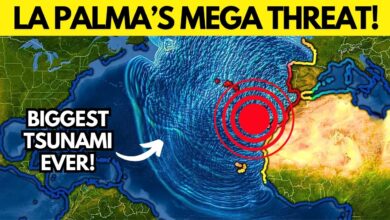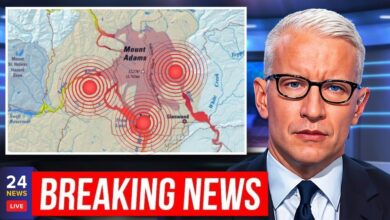Sahara Desert Floods for First Time in Decades, Scientists are PANICKING

Like the iconic scene in *The Day After Tomorrow* where New York faces climate catastrophe, our current reality mirrors the fictional scenario where the Sahara Desert – the largest hot desert on Earth – suddenly experienced its first major flood in half a century this September. The sudden deluge turned stretches of golden sand dunes into vast lakes as a year’s worth of rain fell in just 48 hours, stretching from Morocco to Algeria. Satellite images show the Sahara landscape transformed beyond recognition, with water standing in areas that hadn’t seen rain for decades.
The event was triggered by a rare extratropical storm that originated in the Atlantic and spread deep into the desert, drawing moisture from equatorial Africa in an unusual climate pattern. This resulted in unprecedented rainfall – in just two days, some parts of the Sahara received nearly 20cm of rain, far exceeding the region’s annual average. The town of Aridia in southeastern Morocco recorded nearly 3 inches (7.6 cm) of rain in a short period, four times the normal September total.
The extraordinary storm was enhanced by atmospheric currents laden with water vapor and the towering Atlas Mountains, which help push moist air up and intensify the rainfall. Combined with the typical desert climate, the heavy rain surprised meteorologists and local residents, as the arid desert became a temporary flood zone. This raised new questions about how global climate models can cause unpredictable changes even in dry places like the Sahara.
The event was not just an unusual flood, but also provided important data about how atmospheric dynamics are changing due to global climate change. The extreme rainfall in a short period of time has challenged long-standing climate models, forcing scientists to reassess rainfall predictions for the late summer months. Such events could become more common as a warming climate increases the likelihood of powerful storms. The Sahara, long considered one of the driest and most stable regions, could now face new patterns of extreme weather.

Landscape change is another notable impact of the floods. Large expanses of sand like the town of Muga, famous for its high dunes, now have lakes reflecting the palm trees, creating a surreal and otherworldly scene. In particular, Lake Eri – a dry lakebed in Morocco’s largest national park – has returned to life after more than 50 years of drying up.
NASA satellite images show large patches of water across the desert, opening up opportunities for geologists and hydrologists to study how water behaves in arid environments, and providing data on the Sahara’s wet past thousands of years ago, when it was home to lakes and rich ecosystems.
The sudden appearance of water has brought life back to the land. Many plant species have sprouted from seeds that had lain dormant in the soil for years, creating rare patches of green in the desert. Animal life has also revived, with migratory birds suddenly stopping at newly formed lakes. Microorganisms in the soil, which had been dormant for years, have flourished thanks to the presence of water, creating a nutrient cycle that could have long-term effects on the desert ecosystem.

Along with the ecological benefits, the floods have also caused serious damage, especially in Morocco. At least 18 people have died and much infrastructure has been destroyed. Roads have been washed away, and electricity and drinking water supplies have been cut off in many villages, adding to the hardships of communities still recovering from last year’s earthquake.
The floods forced locals to rethink traditional farming practices, in the hope that water could be harnessed to improve agriculture in a climate that is often drought-prone. However, the floods also exposed weaknesses in infrastructure in desert areas, raising questions about how to better prepare for future extreme weather events.
This unusual flood is a testament to the impact of climate change and its potential to alter climate patterns in desert regions. Climate models predict that as global temperatures rise, similar storms could become more frequent, altering the ecosystem and livelihoods of desert communities.
The history of the Sahara also shows that it was once a humid region, known as the “Green Sahara,” with grasslands and lakes that supported ancient communities some 11,000 years ago. Research into this flood will help scientists improve climate models and understand how the Sahara is likely to change in the future, as well as how humans can adapt to these changes.








